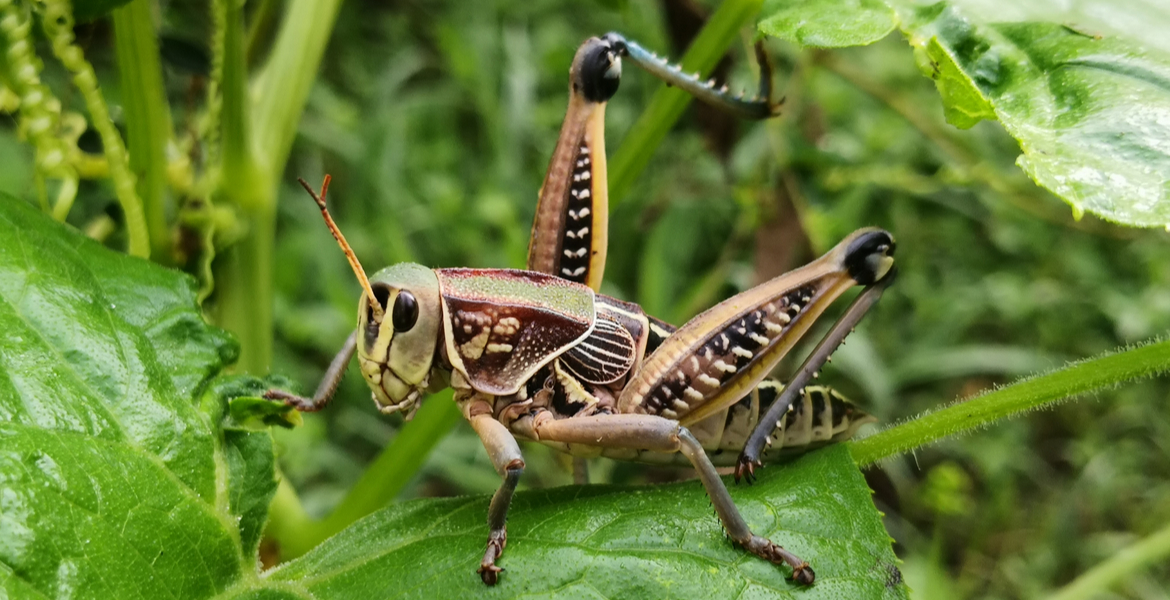
Getting a leg up on grasshoppers in the landscape
Wednesday, August 5, 2020
They look rather prehistoric, and they can make a pretty good smudge mark on a vehicle’s windshield. And oh boy, can they jump and eat.
Fortunately, of the more than 130 resident species of grasshoppers that live in Oklahoma’s forests and grasslands, only a few species become real pest problems, said David Hillock, Oklahoma State University Extension consumer horticulturist. It’s the redlegged, migratory, differential and two-striped grasshoppers that are making themselves the nemeses of gardeners lately.
“Grasshoppers tend to be more problematic in rural areas, especially those surrounded by pastures or rangeland, or urban fringe areas containing large amounts of unkempt ground,” Hillock said. “These leggy pests can be difficult to control in the urban landscape, but homeowners can reduce their impact through the use of barriers and insecticides, along with selecting plants less prone to damage.
All grasshoppers undergo gradual metamorphosis through three life stages, including egg, nymph and adult. Grasshoppers lay eggs in soil during the fall in landscapes such as ditches, fencerows, shelter belts and weedy areas, as well as in harvested crop fields and pastures. Their eggs hatch the following spring.
In general, Hillock said, grasshoppers eat plants, but most specialize on grasses or broadleaf plants. Pest species feed on a wide variety of plants and will readily switch from grasses to broadleaves.
As nymphs, grasshoppers typically stay close to the area where they hatched, as long as there’s an adequate supply of food and shelter. They’ll move out when the food supply runs low. Immature grasshoppers can’t move far because they lack wings, Hillock said.
“However, winged adults can fly for miles in search of new food sources. Hungry grasshoppers like gardens because they have optimal moisture and an abundant food supply,” he said.
Grasshopper control can be challenging because they’re migratory, but by using several control methods – with a hefty dose of persistence and patience – homeowners and workers in agriculture should be able to gain control.
“It’s frustrating when gardeners continue to see grasshoppers even after plants have been sprayed. Unfortunately, even though the treatment killed the grasshoppers that were there, more grasshoppers have moved in to take their place,” he said. “Grasshopper insecticides have a limited residual activity and won’t kill new arrivals after a few days.”
To help cut down on the incidence of grasshoppers, choose plants that do not appeal to a grasshopper’s palette, such as amaryllis, canna lily, iris, mums and wisteria, to name a few. For a more comprehensive list, check out Oklahoma State University Extension’s grasshopper fact sheet.
Treat hatching sites with a registered insecticide. In more suburban areas, work with neighbors to find the sites and develop a neighborhood-wide control program.
Hillock said another option is to purchase floating row covers to protect vegetables and prized plants. The material allows sunlight to get through and allows air circulation, but it’s strong enough to keep grasshoppers from feeding. Also, poultry, especially guinea hens, are effective natural predators.
There are several insecticides registered and effective at killing grasshoppers. Insecticides work better on small grasshoppers because it takes less active ingredient to kill them. However, using insecticides should be the line of last defense.
“None of the insecticides on the market will completely prevent damage from large grasshoppers because they have to do some feeding to pick up enough insecticide to die,” he said. “Even pesticides with the longest-lasting residues will have to be sprayed every three or four days when the grasshopper population is large.”
From an agricultural perspective, chemical control of grasshoppers is more effective
when performed in June before they can fly. Once grasshoppers take wing, they can
easily move from one location to another – wherever the most delectable food sources
are present.
“Currently the grasshoppers are in egg-laying mode,” said Tom Royer, OSU Extension’s
Integrated Pest Management program coordinator. To get the jump on them, he said, “Producers should be assessing
local and area grasshopper populations and planning for next year.”
In addition to insecticide use, producers should have plans in place to keep adjacent
areas around a farmstead and home clear of tall grass and weeds. Grasshoppers use
those areas to feed and build up their populations before moving on to gardens, crop
fields and literally greener pastures.
MEDIA CONTACT: Trisha Gedon | Agricultural Communications Services | 405-744-3625 | trisha.gedon@okstate.edu
